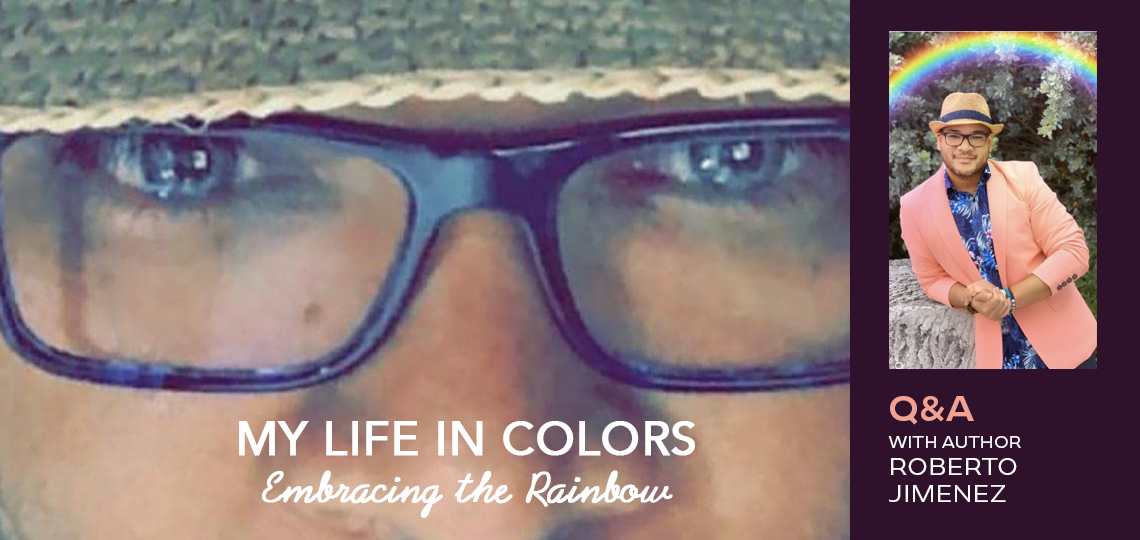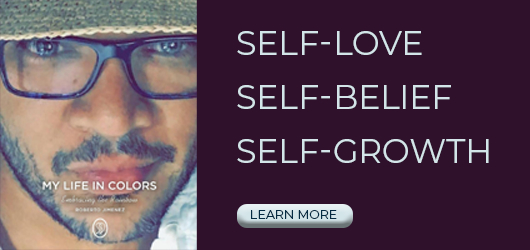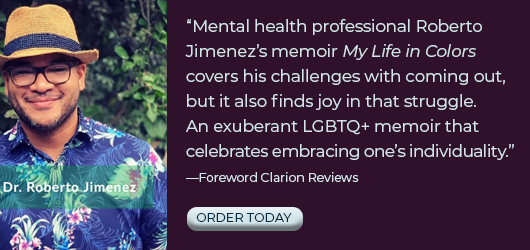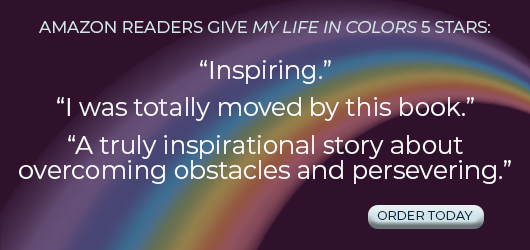Let's celebrate pride together and embrace our true colors

Reviewer Jeremiah Rood Interviews Roberto Jimenez, Author of My Life in Colors: Embracing the Rainbow
To live an authentic, true-to-yourself life requires one character trait more than any other: courage. Without courage, standing up for yourself is intimidating. Without courage, it’s nearly impossible to demand that people accept you for who you are.
And courage is the word that comes to mind when we learn about the remarkable life of Dr. Roberto Jimenez, author of My Life in Colors: Embracing the Rainbow, which earned a glowing Foreword Clarion review from Jeremiah Rood. On the occasion of Pride Month, we set up the following reviewer-author conversation to learn more about Roberto’s courageous and inspiring story.
Let’s begin by talking a bit about your experience with the church. You describe some of the early problems you ran into with the local priest, who did not appreciate your “endless” questioning. I’m wondering if you had run into a different sort of priest, who found the questions engaging, do you think things would have worked out differently? Would you have felt more supported? What’s your relationship to religion now?
I thought about this question many times. The short answer is yes, of course. Having the support of your local priest would have been ideal, but as an adult I wonder if Catholic priests at that time and now know how to help someone like me. Maybe they did not know how. I consider myself to be very spiritual. I believe in God. I know there is a higher power, but I am NOT religious.
Your book raises interesting questions about gender. From an early age, it seems people were concerned that as a boy you were acting “too feminine.” Looking at the world today, gender is still a fault line politically and culturally. Do you think if you were growing up now you’d face the same challenges or is there more support than there was for folks that don’t fit society’s molds?
A lot has changed, thank God. Society was not as accepting back then. I tried to be myself and I was corrected right away. I was given baseball gloves, balls, and trucks as gifts, but I kept choosing dolls. I was transfered to a military school without any explanation. So, no, society was not ready for us. Children and teenagers now have more access to information, services, and resources through the internet. Some parents are more accepting now. Still, we have much work ahead of us but it’s better. It’s a constant battle to maintain what we have accomplished.
My Life in Colors describes a family meeting you had when you were 13 years old, in which you learned that not only were your parents getting a divorce but you needed to decide if you would stay in the Dominican Republic or move to the United States with your mom. You opted for going. I wonder if you’ve ever played “what if” and thought about how things might have been different if you made the other choice. Said another way, do you consider that choice to be a formative one?
That family meeting was traumatic and just very painful for all of us. Looking back, I think my parents handled it poorly, and my brother and I were not supposed to make such decisions.
You describe taking a gender roles class in high school, where you enjoyed the chance to wear a dress to school. We’ve been hinting around a bit at education, but I’m wondering if you could address it more specifically. Do you see any clear connection between education and gender? What do you think needs to change in that regard?
Yes, the gender class in high school was not only fun but also very informative and an eye opener. I learned about gender bias and it prepared me for how to better deal with it as an adult. As a family therapist, I know how important is to educate our children at a young age about gender and ensure gender responsiveness and equality.
Your book is filled with a wonderful mixture of heartbreaking and heartwarming moments. I’m thinking about your brother’s death, following a drug overdose. It’s inspirational to see how you were able to continue on after that moment. It strikes me that this might be another moment where you might second guess yourself or the difficulties you’ve faced might pull you back. How do you keep going?
My older brother, Richard, was everything to me, as he was my first friend and often he was my protector at school. Richard and I just loved one another and, regardless of our differences, we were there for each other. When he passed away, I made him a promise: that I was going to continue with my life and go after my dreams for the both of us.
Of course, while this is your story, you do mention your family and friends. The most moving moment for me was your ability to form a connection with your father-in-law, Alipio, who was able to move from “I don’t want to see you because you are black and you’re gay” to “you’re my son.” Can you flesh that scene out for people? We get a sense of your emotions but miss the details of the moment. Can you tell us a bit more?
Ariel and I have been living together for several years at this point but his family never accepted me 100 percent because I was gay and also had darker skin color than their son, Ariel. One time, I had had enough—I was never invited to family events and always had to leave my own house when they were visiting. So, it was tough for me.
I decided to confront it with love and kindness. I was able to win them over but Alipio was diagnosed with cancer shortly after. We had a conversation and he told me that I was a good person and that he loved me like a son. Of course, I could not stop crying and we hugged for a few minutes. They became my parents, as well. I loved them!
We live in a fraught time. I’m wondering how race plays into your story. Reading your book, I had the sense that it was a memoir more about gender and sexuality, but Alipio’s comment makes me think about the issue of race. What role does race play in your story?
Yes, you are correct: gender and sexuality were two of the main themes. Also, the book is about self-love and trusting yourself regardless of how bad it gets, knowing that you always have a choice. Regarding race, I came from a mixed family, and I saw all skin colors growing up. At home, race was never an issue. In the real world, I did experience some discrimination several times because of my skin color, but that did not stop me. On the contrary, it pushed me to work harder.
What’s it like to be a person of color, Latino and gay?
Coming out to your Latino family as gay or lesbian or trans or bi can be an excruciating experience. It’s super important to be validated, to have equal rights, to create safe spaces for Latino LGBTQ+ so that we can live our lives proudly and authentically, with zero shame!—because this is me.
We’ve covered a lot of ground, from gender to education to race, but we haven’t talked much about your experience writing the book. Can you tell people something about what the process was like and what you learned from it?
Writing this book was a lot of work, but it was therapeutic, and the process helped me heal some old wounds. And yes, we have covered quite a bit; thank you so much for your time and this opportunity.
Jeremiah Rood



